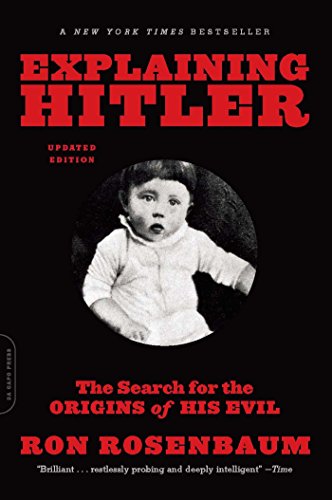Hitler: Evil Unprecedented
Explaining Hitler: The Search for the Origins of His Evil
Ron Rosenbaum. 1998. Random House, New York, and Macmillan Publishers Ltd., London. 444 pages.
Hitler, 1889–1936: Hubris
Ian Kershaw. 1998. Penguin Press, London. 845 pages.
Hitler: The Pathology of Evil
George Victor. 1998. Brassey's, Washington, D.C., and London. 262 pages.
Few will deny that in Adolf Hitler evil was personified. His name is the yardstick against which we judge the grossest of human cruelties. The nature of his character and the depths of his depravity have been well documented in a multitude of books and articles published since World War II. Many authors have attempted an analysis of this demonic figure, who perpetrated what many consider to be the worst outbreak of evil in the 20th century—the extermination of multiple millions, including some two thirds of European Jewry.
More than 50 years after the war, fascination with Hitler’s persona continues to prey on the modern mind and shows no sign of abating. Three books published in 1998 attempt to shed additional light on the subject.
In Explaining Hitler, Ron Rosenbaum probes Hitler’s character and background in an effort to discover why evil so dominated the man. Rosenbaum quotes many sources, providing a valuable overview of the available literature. He combines a broad historical survey with original reportage and controversial commentary to reveal a variety of opinions about human nature and the evil it may produce.
Ian Kershaw’s Hitler, 1889–1936: Hubris is an 845-page tome. A comprehensive reference work about Hitler’s rise to power, it recreates the world that nurtured the young Hitler and allowed him to gain control. Professor Kershaw, one of the world’s leading authorities on Hitler, explains why so many people, far from resisting Hitler, instead adored him and even plotted with him. Drawing on a huge range of sources, Kershaw endeavors to bring the reader to a deeper understanding both of the man and of the events that brought him to power.
In Hitler, The Pathology of Evil, George Victor presents a penetrating psychohistory. He explains how Hitler coerced an entire nation, broadly speaking, to help him implement the Final Solution—his diabolical plan to exterminate all Jews and even Germans with Jewish blood in their veins.
Taken together, these three recent works set out to advance the reader’s understanding of Hitler’s awful and unprecedented role in the 20th century. Is there a rational explanation for Hitler’s evil?
Tangled Roots
The cover of Rosenbaum’s book shows Hitler as a baby. The author spent nearly a decade studying the works of historians, psychologists, philosophers, artists and theologians who have struggled to understand what caused that innocent child to become the perpetrator of genocide.
Rosenbaum describes his research into Hitler’s genealogy. The führer’s grandmother was Maria Schicklgruber. When she gave birth to Hitler's father, Alois, the space for the father's name on the birth certificate was left blank. Some later spread the story that Hitler's grandfather was a Jew named Frankenberger. Though Rosenbaum could not find any firm evidence to support such a claim, it is noteworthy that Hitler wanted the story squelched. He even went to the extent of destroying the town of Doellersheim, where his father was born. In response to investigations into his background, he is said to have ranted, “People must not know who I am. . . . They must not know where I come from” (Explaining Hitler).
According to Rosenbaum, one person who believed the story about Hitler’s Jewish lineage was American psychologist G.M. Gilbert. Rosenbaum listened to a taped interview Gilbert gave to John Toland, author of Adolf Hitler (Doubleday, 1976).
“Gilbert sees that moment in 1930 when Hans Frank purportedly told Hitler he had come upon documentary proof that his father was fathered by a Jew,” says Rosenbaum, “as a profound turning point in the evolution of Hitler’s anti-Semitism. ‘Especially when [Hitler] was already committed to being a violent anti-semite with his whole ego structure depending upon this,’ Gilbert told Toland, ‘the idea that [the Jewish grandfather story] could have been true could have been resolved in his sick mind only by showing, as Frank said, that he was the worst anti-semite in the world, so how could he possibly be a Jew?’” (Explaining Hitler).
Other factors in Hitler’s background may also have influenced his development. From what little we know of his childhood, it is evident that he did not grow up in a happy family atmosphere. Some claim that his father was abusive and prone to drunkenness.
Documenting some of these claims, Rosenbaum briefly quotes the work of another American psychologist, Walter C. Langer. His book, The Mind of Adolf Hitler, began as a secret report compiled during World War II for the American Office of Strategic Services. Langer was responsible for providing a thorough analysis of Hitler’s psychological makeup. In the process, he gathered all the information he could muster concerning Hitler's mind and character. (Rosenbaum is critical of some of Langer's information and could have made more use of Langer's enlightening analysis of the working of Hitler's mind, including his sexual pathologies, death fears, Messiah complex and troubled family history.)
In his book, Langer describes Hitler's father as “brutal, unjust, and inconsiderate. He had no respect for anybody or anything. . . . [He] played the part of the bully and whipped his wife and children who were unable to defend themselves. Even the dog comes in for his share of this sadistic display” (The Mind of Adolf Hitler).
Others speculate that Hitler came to hate his father and that, as his hatred increased, he became more dependent upon the affection and love of his mother. But does that parental relationship explain why Hitler became so filled with evil?
Rosenbaum refers to his discussion with French filmmaker Claude Lanzmann and writes, “No finite number of explanatory facts—psychological traumas, patterns of bad parenting, political deformations, personal dysfunctions—can add up to the magnitude of the evil that Hitler came to embody and enact. No explanation or concatenation of explanations can bridge the gap, explain the transformation from baby picture to baby killer, to murderer of a million babies. It is not just a gap, Lanzmann argues; it is an abyss” (Explaining Hitler, emphasis his).
Yet there are indicators that show how that harmless baby could have turned into an evil monster. For example, look at Hitler’s adolescence as described in Ian Kershaw’s book. “Adolf’s adolescence, as he commented in Mein Kampf,” Kershaw says, “was ‘very painful.’ With the move to the secondary school in Linz, and the start of the rumbling conflict with his father, an important formative phase in his character development had begun. The happy, playful youngster of the primary school days had grown into an idle, resentful, rebellious, sullen, stubborn, and purposeless teenager” (Hubris).
George Victor quotes a teacher in the Linz school, who reported that Hitler “was notoriously cantankerous, willful, arrogant, and bad tempered. . . . He reacted with ill-concealed hostility to advice and reproof” (Pathology of Evil).
“We know he defined himself in his childhood as an artist. . . . We know that after his father’s death he felt liberated enough to set out for Vienna to pursue his artistic dream—only to be brutally disillusioned when he was rejected as lacking the talent even to study art. . . . it was a rejection that was to have a shattering and lasting impact on his life.”
From his youth, Hitler aspired to become a great artist. Rosenbaum notes: “We know he defined himself in his childhood as an artist; we know his assertion of that identity set him in conflict with his powerful father, who disapproved, and brought him closer to his mother, who encouraged the sensitive-soul side of young Adolf. We know that after his father’s death he felt liberated enough to set out for Vienna to pursue his artistic dream—only to be brutally disillusioned when he was rejected as lacking the talent even to study art at the Vienna Academy of Fine Arts. It was a rejection that was to have a shattering and lasting impact on his life” (Explaining Hitler, emphasis his).
As a young man, Hitler spent a number of years in Vienna living in a hostel, or doss-house. He had a reputation for never trusting anyone. He never committed himself or admitted loyalty to anyone. He learned to lie with conviction, adhering to the principle that if you lie, you should tell big lies. As he put it in Mein Kampf: “The great masses of the people . . . more easily fall victim to a big lie than to a little one.”
Mandate From “Providence”
Hitler joined the army in 1914. He wrote about several wartime experiences that convinced him he had divine guidance.
One such experience took place in October 1918. After being gassed, he ended up in an army hospital suffering from blindness and dumbness. “It was a life-changing moment of metamorphosis,” Rosenbaum writes, “brought on by the news of the German army surrender—a surrender that, he makes clear in his own account of the moment in Mein Kampf and elsewhere, was accompanied by a simultaneous sickening sense that the November surrender was a betrayal, a sellout, a stab in the back. In that moment of utter collapse (personal and national), total despair, and then subsequent visionary (or hallucinatory) summons, Hitler conceived the mission and the myth that would bring him to power fifteen years later” (Explaining Hitler).
Langer goes further, saying:“It was while he was in the hospital suffering from hysterical blindness and mutism that he had a vision that he would liberate the Germans from their bondage and make Germany great. It was this vision that set him on his present political career and that has had such a determining influence on the course of world events. More than anything else it was this vision that convinced him that he was chosen by Providence and that he had a great mission to perform. This is probably the most outstanding characteristic of Hitler’s mature personality, and it is this that guides him with the ‘precision of a sleepwalker’” (The Mind of Adolf Hitler).
The phrase about sleepwalking is from Hitler’s speech in Munich on March 14, 1936, when he said, “I go with the certainty of a sleepwalker along the path laid out for me by Providence” (Hubris).
On the morning after having the vision, Hitler’s sight is said to have returned and his depression lifted. With renewed spirit and energy, he then dedicated himself to a political career and to fulfilling the mission given him by “Providence.”
In September 1919 the army sent Hitler to observe and report on a local group called the German Workers’ Party. Though it later became known as the National Socialist German Workers' (Nazi) Party, at the time it was a small organization that functioned only as a discussion group.
When Hitler attended a public meeting held by the party, he became so indignant at a statement made by a member of the audience that he could not restrain himself from giving a rebuttal. The leaders were so impressed by his speech that they asked him to join the party and take on the role of star speaker. Hitler accepted, and his political career took off.
He went on, of course, to become the charismatic leader who seduced the German masses. His fiery oratory stirred patriotic sentiments in the German heart. As his audience responded, Hitler became even more dynamic. Audience and speaker fed on each other in a kind of synergy.
This process was well described years earlier by Friedrich Nietzsche in his book Human, All Too Human, as Rosenbaum quotes: “In all great deceivers a remarkable process is at work to which they owe their power. In the very act of deception with all its preparations—the dreadful voice, the expression, the gestures—they are overcome by their belief in themselves, and it is this belief which then speaks so persuasively, so miracle-like to the audience. Not only does he communicate that to the audience but the audience returns it to him and strengthens his belief” (Explaining Hitler, emphasis added).
The Nazi Religion
Hitler had a strong belief in his role as the leader—der Führer—of Germany. The strong parallels between the Nazi movement and a religion are apparent. Hitler believed he was called by Providence to fulfill his destiny as a messiah and lead the German people to glory.
As his political career progressed, it is evident that Hitler thought of himself as a Chosen One—a second Christ who was to institute a New World Order.
As his political career progressed, it is evident that Hitler thought of himself as a Chosen One—a second Christ who was to institute a new world order. He exhibited a religious fervency and frequently referred to the Bible. Victor describes Hitler’s vision of a future where “he would seek a gracious land and a godlike people in Germany. And not finding them there, he would try to redesign Germany, transform its people into supermen, and get them to honor him as a god” (Pathology of Evil).
The Nazi Party adopted this creed: “We all believe, on this earth, in Adolf Hitler, our Führer, and we acknowledge that National Socialism is the only faith that can bring salvation to our country.” In April 1937 a group of German Christians passed this resolution: “Hitler’s word is God’s law, the decrees and laws which represent it possess divine authority” (The Mind of Adolf Hitler).
Rosenbaum refers to Hitler’s charisma and the hypnotic spell he cast over people. News films of that period illustrate how much his emotional oratory and manic charisma compare to those of an evangelist at a revival meeting. The colorful flags, torchlight parades and arm waving all contributed to a revival-like atmosphere that swayed the masses by the thousands.
Victor comments on the same phenomenon in chapter 10 of his book. He quotes one man’s observation of the people who lined the road to greet Hitler. They had a “facial expression of an almost biblical devotion . . . as if in ecstasy and almost bewitched. It was like mass intoxication.” Victor said that “many who went to listen with skepticism or even opposition were converted. A new follower said he saw a halo around Hitler's head” (Pathology of Evil).
Hypnotist or Hypnotized?
But what kind of man was this new leader of Germany? As Hitler rose to power during the 1930s, international industrialists and bankers—even the Roman Catholic Church—gave him support. They saw him as a potent bulwark against the encroachment of Soviet communism. Against a background of widespread anti-Semitic feelings, his rhetoric did not initially arouse undue opposition. His steady rise was often downplayed and underestimated, both at home and abroad.
Still, many in the West suspected that he was probably a neurotic psychopath. Some called him a madman. Langer said that he had many characteristics that bordered on the schizophrenic. As a well-known chronicler of German history, H.R. Trevor-Roper believed Hitler had demonic energy—something more than human power. His eyes had hypnotic power over those who came in contact with him.
Others noticed the glaze in Hitler’s eyes as he spoke to the crowds. He was like a man hypnotized, “transformed and possessed” as he worked himself into a frenzy.
Here was a man who had personal magnetism, “demonic energy,” and a mission from so-called Providence to lead a nation to carry out the most horrendous crimes of the century. We most often think of the torture and killing, either directly or indirectly, of some six million Jews, but what about the British, French, Russians and Americans who died on the battlefield and the countless British and European civilians who simply found themselves in the way of Hitler’s blitzkrieg? In addition, Hitler made a specific point of persecuting and killing gypsies, Slavs, blacks, Roman Catholics, Jehovah’s Witnesses, Freemasons, communists, social democrats and homosexuals, all of whom he viewed as inferior human beings. Thousands of those who made up these persecuted groups were Germans; they, too, died in the concentration camps. Many others across Europe perished through malnutrition, sickness and mistreatment under the Nazi regime.
Milton Himmelfarb, author of a 1984 essay titled No Hitler, No Holocaust and described by Rosenbaum as an “influential polemicist,” told Rosenbaum what he thought of Hitler. Commenting on attempts to classify Hitler, he said, “I don’t think he was a statesman. I don’t think he was an accidental agent. I think he was an evil man, an evil genius” (Explaining Hitler, emphasis his).
While some people may be reluctant to use the word evil to describe Hitler, others think he was the most evil man who ever lived. But are these books able to explain why he became so evil?
A Criminal Nation?
We have already seen indications that there was some kind of supernatural power responsible for the actions of Adolf Hitler. Although numerous authors have explained how normal criminals develop their kind of behavior from childhood, it is more difficult to explain Hitler’s “radical evil” and why his leadership was an “eruption of demonism into history,” as theologian Emil Fackenheim described it to Rosenbaum.
“Fackenheim sees Hitler as more than just a very, very, very bad man, in the sense of ordinary human badness,” Rosenbaum states, “but something else again entirely, something beyond that, the meaning of which we need to search for not in psychology but in theology. The explanation for which, if there is one, can be known or fathomed only by God” (Explaining Hitler).
Rosenbaum points out that Edmund Goldschagg, a Munich Post reporter, always referred to Hitler as a “political criminal.” But the evil of Hitler is surely only part of the story. Certainly there would have been no Holocaust without Hitler’s evil vision and obsessive leadership. But neither would there have been the Holocaust without multiple thousands of those who shared his vision and who were willing to carry out his murderous directives. Hitler was technically not a mass murderer—but the “archconceiver” of atrocities which others then executed.
What happened in Germany was that a majority of Germans came to support, actively or passively, criminal acts perpetrated by their leadership. Lawlessness flourished when the Nazi Party came to power. Hitler and his henchmen flouted the laws of the land to get their own way, and they influenced and compromised otherwise law-abiding citizens to do the same. The tragedy is that many people went along with the system for their own survival.
Victor describes this massive involvement by saying that “Hitler’s regime was basically criminal, and a great many people were drawn into complicity. Officers of the justice system—police, prosecutors, judges, aided by clerks and lawyers—became criminals by involvement in the system's operation. Many people participated by spying on others and denouncing them. . . . In all, as accessories and beneficiaries of crimes, many millions of Germans became accomplices” (Pathology of Evil).
Of course, not all German people were the evil accomplices of Hitler. By no means were all Germans Nazis; indeed, the period of Nazi domination is seen by numerous observers as an unnatural blight—an aberration—not in keeping with national character. Germany and the rest of the world are even yet coming to terms with that aberration.
Today most observers would acknowledge that Nazism and the anti-Jewish culture prevalent in the 1930s have been largely extinguished. Germany is overtly peace-loving and democratic—though memories of the Nazi period of her history are never likely to be completely forgotten and, for some, nagging doubts will forever remain.
The point is that the capacity of human nature to do evil will vary according to individual circumstances. Freedom to do evil is limited by others in authority. Today one could murder only so many people before being arrested and incarcerated or executed. Because Hitler and the Nazi Party were the supreme authority over the German nation, they had the capacity to murder millions of Jews in the Holocaust before being stopped by the Allied powers. When a nation ignores or feels forced to accept the criminal activities of its government, it can allow atrocities and even genocide to take place.
Few dispute that the Holocaust represents Hitler’s evil at its fullest extent. But it also says much about additional thousands of people willing to share Hitler’s evil vision—“willing executioners” who fulfilled Hitler's murderous objectives. Death camps such as Auschwitz and Buchenwald revealed most vividly how horrendously evil people can be when they function without any restraint.
What Is Evil?
Rosenbaum defines evil as “a capacity of human nature.” He asks: “To what degree does Hitler represent some ultimate, perhaps never-before-seen extension of that capacity? Or does he represent not a qualitative leap in that capacity but rather a figure whose distinctiveness and importance in this regard have been inflated by the quantity of his victims?” (Explaining Hitler).
The information in these three recently published books attempts to shed light on how Hitler may have become so evil, but the authors do not satisfactorily explain what that evil is and where it comes from. Perhaps in human terms we shall never know for sure, for the complete answer will not be found in either history or psychology.
We need not be left in the dark about the origin of evil and why evil dictators are allowed to perpetrate horrendous crimes against humanity. God has spoken and revealed the truth about these matters in His Word.
If we are seeking to understand the evil nature of such men as Adolf Hitler, we can turn to the Bible. It gives answers to questions that puzzle historians, psychologists and many theologians. Future issues of Vision will continue to explore this vital theme.




